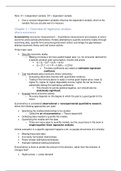Date: 30/08/2022
Knowledge clips lecture 1
Part 1: A vision of international law
● Examples of what we think about when talking about international law:
- Rules on trade of goods
- Rules on protecting the environment
- Rules on the conduct of war
- Rules on tackling pandemics and IP rules on vaccine patents
● What international law is not:
- International law is not private international law, which are the rules
governing conflicts of laws between individuals within different countries
trying to figure out which domestic law applies when making a
transnational contract (for example when trying to make a contract with a
firm that exists in Finland, and you have a dispute about one of the terms,
and are trying to figure out whether you will bring that dispute to a Finnish
court or an Australian court). This is private international law, it does not
involve states or countries but is a private matter.
- International law is also not international relations. (Global politics,
concepts like realism or constructivism) A separate field of study with its
own understanding of international law, but international law deals with
, 2
the normative constraints placed on global actors. Really about
constraining the behavior of certain actors at the global level, whereas
international relations is often looking at more empirical questions such
as why states would obey something like international law
- International law is not transnational law. Area of law dealing with cross-
border cooperation on criminal investigations (police having relations with
police in other countries), extradition. International law is not operating at
that sub level of international law, but more at the national level between
one state as a whole and another state as a whole.
- International law as the body of rules regulating the (public) conduct of
equal sovereign states.
● There is no single overarching authority: no world government
- This means we end up with a system called ‘sovereign equality of states’
(a ‘horizontal’ system- all states are equal to all other states):
- States can create rules/ principles (law-makers) (how to protect the
environment, how to deal with other states)
- That create rights and obligations that are also binding upon them
(law-abiders). Having to comply with the rules they themselves are
creating.
● Centrality of consent: states consent to be bound by rules. A state voluntarily
enters into relations with other states, and therefore has to comply to the rules
they create for themselves
- But if one both makes the rules and is bound by them, then how is this
really a normative system that constrains behaviour?
- By a range of other things that prevents states from getting out of their
obligations:
- Good faith, promising that you are going into the contract meaning
to uphold the rules you have consented into in the past.
- Values, is not just a set of rules, but also a representation of the
values they want to uphold in the world (human rights)
- Expectations, it also does not look good to other states that one
day you submit to certain rules and the next day you try to get out
of the rules. If you want to cooperate with other states at global
level, that will create expectations and it will make it easier for you
, 3
as a state to contract with other states and be able to achieve
certain ends
- Contextual factors
● Consent in practice:
- Formal equality v. substantive inequality (yes all states are equal, however
some countries are more powerful due to money or military advantages)
- Example: Sudan loans money from the US to relieve debts and sudan's
national budget can be used for roads, national health care etc.
- Sudan is limited in its options, compared to wealthier countries
- Sudan signs up to loan agreement because it needs the money
- So consent to one state may look like acquiescence, pressure or coercion
to another
● International law is the body of rules regulating the public conduct of equal
sovereign states. But, does this traditional definition stand up to modern
scrutiny? What 21st century developments might challenge this definition?
- International law is not only the rules between states anymore. States are
no longer the only actors, e.g. companies, NGOs, individuals. Companies
who are subject to regulations, NGOs who are involved in making laws,
and individuals who are bearers of human rights, but may also be held
accountable if they commit grave crimes.
- All states are also not really equal. In the 21st century, when global
inequality is rising, international law has a part to play in this. It is
promoting equality on one level but may also be reinforcing inequality on
another level.
- Globalization has also expanded the body of rules that regulate the
conduct between global actors. It has brought forth a wide range of new
‘law’, for example WHO International Health Regulations on global health
risks, or Paris Climate Agreement. Are these international law?
- It is no longer one vision on international law but many. It's a system that
is quite complex, it is based on the sovereign equality of states and the
body of rules that regulate their global conduct.
Part 2: multiple visions of international law











